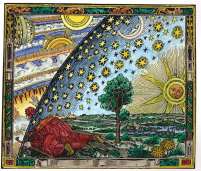Kabbalah began its life as a part
of Jewish mysticism, and was largely concerned with esoteric interpretations of the Torah, and with rituals of mysticism and
magick based on them. At one time it was widely studied and practiced by Rabbis and devout Jews, and it was said that Kabbalah
was the soul, and that conventional Judaism was the body of religion.
Over time, and after suppression by
priests wishing to maintain the authority of their role as intermediaries between god and man, the practice declined and was
largely forgotten amongst the Jewish community. It was later to be rediscovered by others. In the medieval period it was widely
studied by Christians, who called it Cabala to distinguish it from the original Jewish version. In more recent times it has
flourished amongst students of esoteric philosophy, magick and the occult. This most recent incarnation of the holy Kabbalah,
known by the variant spelling Qabalah, is really quite close in spirit to the vision of the perennial philosophy. Students
of Qabalah generally study the subject outside of any religious dogma, and become students of comparative religion.
What really makes Qabalah stand out
as a candidate for the perennial philosophy are the tables of correspondences first popularized by Aleister Crowley, who described
the Qabalistic representation of the Tree of Life as a ‘spiritual filing cabinet’. The tree of life consists of
10 spheres and 22 connecting paths, which are the fundamental forms, or archetypes, of all things. As the deeper truths they
represent cannot be adequately described by language the tables of correspondences provide a method by which a student can
gain a more intuitive and holistic understanding through the mechanism of the subconscious mind - association.
Various symbols, ideas, and through
meditation even personal experiences, are all associated with the sphere or path
they are derived from, and thus an understanding of the deeper truths of the spheres of existence are built up in the mind
through meditation on these various things and what unites them.
These tables of correspondences have
been built up to include the symbols and ideas of religions as diverse as Christianity, Hinduism, Taoism, Egyptian Paganism
and many more – and with a surprisingly high degree of success.
The third sphere of Binah, for example,
is associated with (amongst many others):
Saturn, The Queens of the Tarot, Nephthys,
Bhavani, The Virgin Mary, Yin, the Khwan trigram, and the philosophical death of Alchemy and Hermetic philosophy.
So although Qabalah cannot explicitly
tell you what the perennial philosophy says about the universe, through the use of the Tree of Life it can give you a method
through which you can find out for yourself.

